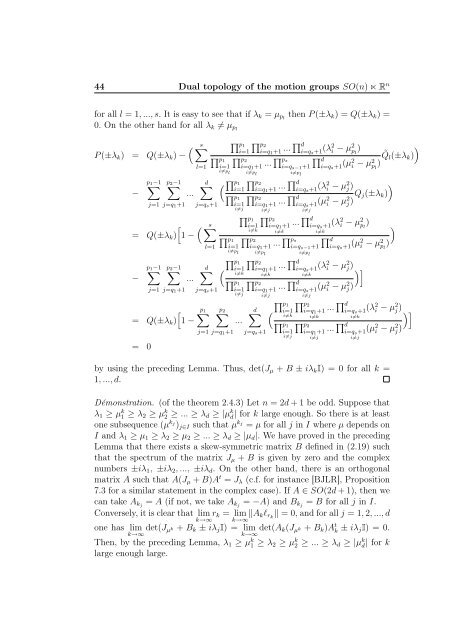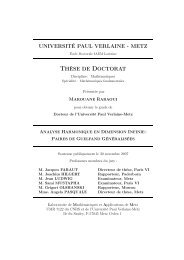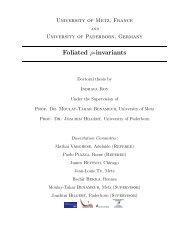Create successful ePaper yourself
Turn your PDF publications into a flip-book with our unique Google optimized e-Paper software.
44 Dual topology of the motion groups SO(n) ⋉ R n<br />
for all l = 1, ..., s. It is easy to see that if λk = µpl then P (±λk) = Q(±λk) =<br />
0. On the other hand for all λk �= µpl<br />
� �s<br />
P (±λk) = Q(±λk) −<br />
−<br />
� � �s<br />
= Q(±λk) 1 −<br />
−<br />
� � p1 p2<br />
i=1 i=q1+1<br />
l=1<br />
... �d i=qs+1 (λ2i − µ 2 pl )<br />
� � p1 p2<br />
i=1 i=q1+1 ...<br />
i�=pl i�=pl � � ps<br />
d<br />
i=qs−1+1 i=qs+1<br />
i�=pl (µ2i − µ2pl )<br />
p1−1 p2−1 � � d� �<br />
...<br />
j=1 j=q1+1 j=qs+1<br />
� � p1 p2<br />
i=1 i=q1+1 ... �d i=qs+1 (λ2i − µ 2 j)<br />
� � p1 p2<br />
i=1 i=q1+1 ...<br />
i�=j i�=j<br />
�d i=qs+1(µ<br />
i�=j<br />
2 i − µ2j )Qj(±λk)<br />
�<br />
� � p1 p2<br />
i=1 i=q1+1 ...<br />
i�=k i�=k<br />
l=1<br />
�d i=qs+1(λ<br />
i�=k<br />
2 i − µ 2 pl )<br />
� � p1 p2<br />
i=1 i=q1+1 ...<br />
i�=pl i�=pl � � ps<br />
d<br />
i=qs−1+1 i=qs+1<br />
i�=pl (µ2i − µ2pl )<br />
�<br />
� � p1 p2<br />
p1−1 p2−1 � � d� � i=1 i=q1+1 ...<br />
i�=k i�=k<br />
...<br />
j=1 j=q1+1 j=qs+1<br />
�d i=qs+1(λ<br />
i�=k<br />
2 i − µ 2 j)<br />
� � p1 p2<br />
i=1 i=q1+1 ...<br />
i�=j i�=j<br />
�d i=qs+1(µ<br />
i�=j<br />
2 i − µ2j )<br />
��<br />
� � p1 p2<br />
p1 p2 � � d� � i=1 i=q1+1 ...<br />
i�=k i�=k<br />
...<br />
j=1 j=q1+1 j=qs+1<br />
�d i=qs+1<br />
i�=k<br />
� � p1 p2<br />
i=1 i=q1+1 ...<br />
i�=j i�=j<br />
�d i=qs+1(µ<br />
i�=j<br />
2 i − µ2j )<br />
�<br />
= Q(±λk) 1 −<br />
= 0<br />
�<br />
˜Ql(±λk)<br />
(λ2 i − µ 2 j) ��<br />
by using the preceding Lemma. Thus, <strong>de</strong>t(Jµ + B ± iλkI) = 0 for all k =<br />
1, ..., d.<br />
Démonstration. (of the theorem 2.4.3) Let n = 2d + 1 be odd. Suppose that<br />
λ1 ≥ µ k 1 ≥ λ2 ≥ µ k 2 ≥ ... ≥ λd ≥ |µ k d | for k large enough. So there is at least<br />
one subsequence (µ kj )j∈I such that µ kj = µ for all j in I where µ <strong>de</strong>pends on<br />
I and λ1 ≥ µ1 ≥ λ2 ≥ µ2 ≥ ... ≥ λd ≥ |µd|. We have proved in the preceding<br />
Lemma that there exists a skew-symmetric matrix B <strong>de</strong>fined in (2.19) such<br />
that the spectrum of the matrix Jµ + B is given by zero and the complex<br />
numbers ±iλ1, ±iλ2, ..., ±iλd. On the other hand, there is an orthogonal<br />
matrix A such that A(Jµ + B)At = Jλ (c.f. for instance [BJLR], Proposition<br />
7.3 for a similar statement in the complex case). If A ∈ SO(2d + 1), then we<br />
can take Akj = A (if not, we take Akj = −A) and Bkj = B for all j in I.<br />
Conversely, it is clear that lim rk = lim �Akℓrk� = 0, and for all j = 1, 2, ..., d<br />
k→∞ k→∞<br />
one has lim<br />
k→∞ <strong>de</strong>t(J µ k + Bk ± iλjI) = lim<br />
k→∞ <strong>de</strong>t(Ak(J µ k + Bk)A t k ± iλjI) = 0.<br />
Then, by the preceding Lemma, λ1 ≥ µ k 1 ≥ λ2 ≥ µ k 2 ≥ ... ≥ λd ≥ |µ k d | for k<br />
large enough large.





